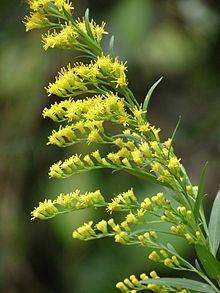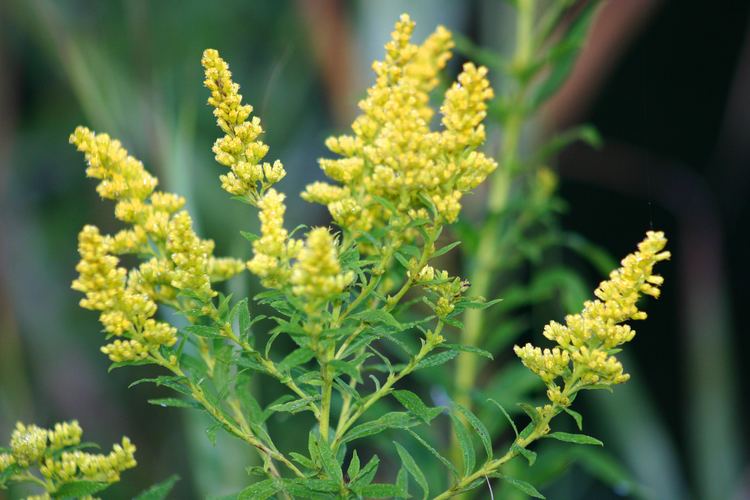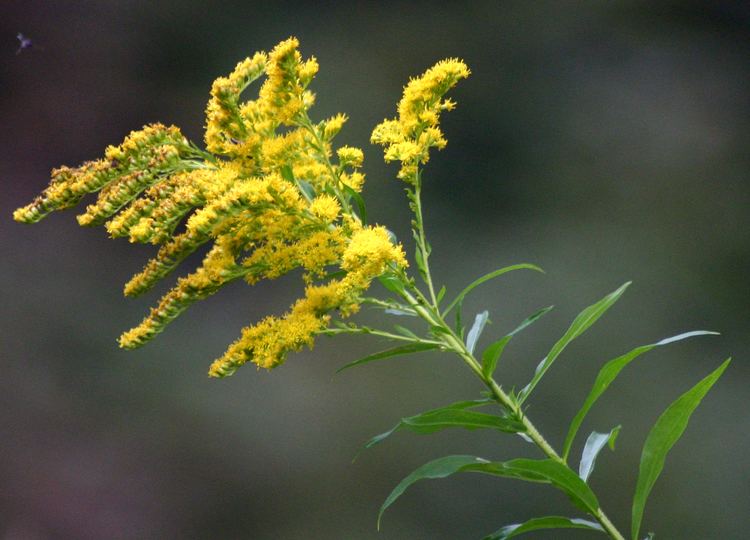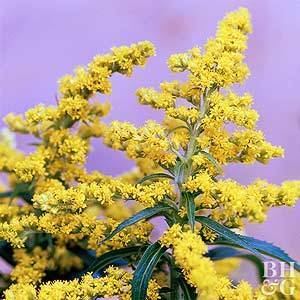Kingdom Plantae Tribe Astereae Higher classification Astereae Symbol of Nebraska, Kentucky | Order Asterales Subfamily Asteroideae Scientific name Solidago Rank Genus | |
 | ||
Lower classifications Solidago virgaurea, Solidago canadensis, Solidago gigantea, Solidago altissima, Solidago rugosa | ||
Goldenrod solidago rugosa fireworks how to grow goldenrod
Solidago, commonly called goldenrods, is a genus of about 100 to 120 species of flowering plants in the aster family, Asteraceae. Most are herbaceous perennial species found in open areas such as meadows, prairies, and savannas. They are mostly native to North America, including Mexico; a few species are native to South America and Eurasia. Some American species have also been introduced into Europe and other parts of the world.
Contents
- Goldenrod solidago rugosa fireworks how to grow goldenrod
- Goldenrod solidago luminearth s how to identify wild edible medicinal plants
- Description
- Use and cultivation
- Cultivated species
- Industrial use
- Traditional medicine
- Cultural significance
- Diversity
- References

Goldenrod solidago luminearth s how to identify wild edible medicinal plants
Description

Solidago species are perennials growing from woody caudices or rhizomes. Their stems ranges from decumbent (crawling) to ascending or erect, with a range of heights going from 5 cm to over a meter. Most species are unbranched, but some do display branching in the upper part of the plant. Both leaves and stems vary from glabrous (hairless) to various forms of pubescence (strigose, strigillose, hispid, stipitate-glandular or villous). In some species, the basal leaves are shed before flowering. The leaf margins are most commonly entire, but often display heavier serration. Some leaves may display trinerved venation rather than the pinnate venation usual across Asteraceae.

The flower heads are usually of the radiate type (typical daisy flower heads with distinct ray and disc florets) but sometimes discoid (with only disc florets of mixed, sterile, male and bisexual types). Only ray florets are female, others are male, hermaphroditic or entire sterile. Head involucres are campanulate to cylindric or attenuate. Floret corollas are usually yellow, but white in the ray florets of a few species (such as Solidago bicolor); they are typically hairless. Heads usually include between 2 and 35 disc florets, but in some species this may go up to 60. Filaments are inserted closer to the base of the corolla than its middle. Numerous heads are usually grouped in complex compound inflorescences where heads are arranged in multiple racemes, panicles, corymbs, or secund arrays (with florets all on the same side).

Solidago cypselae are narrowly obconic to cylindrical in shape, and they are sometimes somewhat compressed. They have eight to 10 ribs usually and are hairless or moderately hispid. The Pappus is very big with barbellate bristles.
The many goldenrod species can be difficult to distinguish, due to their similar bright, golden-yellow flower heads that bloom in late summer. Propagation is by wind-disseminated seeds or by spreading underground rhizomes which can form colonies of vegetative clones of a single plant. They are mostly short-day plants and bloom in late summer and early fall. Some species produce abundant nectar when moisture is plentiful, or when the weather is warm and sunny.
Use and cultivation
Young goldenrod leaves are edible. Native Americans used the seeds of some species for food. Herbal teas are sometimes made with goldenrod.
Goldenrod often is inaccurately said to cause hay fever in humans. The pollen causing this allergic reaction is produced mainly by ragweed (Ambrosia sp.), blooming at the same time as the goldenrod and pollinated by wind. Goldenrod pollen is too heavy and sticky to be blown far from the flowers, and is pollinated mainly by insects. Frequent handling of goldenrod and other flowers, however, can cause allergic reactions, sometimes irritating enough to force florists to change occupation. Goldenrods are attractive sources of nectar for bees, flies, wasps, and butterflies. Honey from goldenrods often is dark and strong because of admixtures of other nectars. However, when honey flow is strong, a light (often water-clear), spicy-tasting monofloral honey is produced. While the bees are ripening the honey produced from goldenrods, it has a rank odor and taste; the finished honey is much milder.
Goldenrods are, in some places, considered a sign of good luck or good fortune. They are considered weeds by many in North America, but they are prized as garden plants in Europe, where British gardeners adopted goldenrod as a garden subject long before Americans did. Goldenrod began to gain some acceptance in American gardening (other than wildflower gardening) during the 1980s.
They have become invasive species in other parts of the world, including China; Solidago canadensis, which was introduced as a garden plant in Central Europe, has become common in the wild, and in Germany is considered an invasive species that displaces native vegetation from its natural habitat.
Goldenrod species are used as a food source by the larvae of many Lepidoptera species. The invading larva may induce the plant to form a bulbous tissue mass called a gall around it, upon which the larva then feeds. Various parasitoid wasps find these galls and lay eggs in the larvae, penetrating the bulb with their ovipositors. Woodpeckers are known to peck open the galls and eat the insects in the center.
Cultivated species
Cultivated goldenrods include S. bicolor, S. caesia, S. canadensis, S. cutleri, S. riddellii, S. rigida, S. shortii, and S. virgaurea.
A number of cultivars have been selected, including several of hybrid origin. A putative hybrid with aster, known as ×Solidaster is less unruly, with pale yellow flowers, equally suitable for dried arrangements. Molecular and other evidence points to ×Solidaster (at least the cultivar 'Lemore') being a hybrid of Solidago ptarmicoides and Solidago canadensis, the former now in Solidago, but likely the "aster" in question.
The cultivars 'Goldenmosa' and S. × luteus 'Lemore' have gained the Royal Horticultural Society's Award of Garden Merit.
Industrial use
Inventor Thomas Edison experimented with goldenrod to produce rubber, which it contains naturally. Edison created a fertilization and cultivation process to maximize the rubber content in each plant. His experiments produced a 12-foot-tall (3.7 m) plant that yielded as much as 12% rubber. The tires on the Model T given to him by his friend Henry Ford were made from goldenrod. Like George Washington Carver, Henry Ford was deeply interested in the regenerative properties of soil and the potential of alternative crops such as peanuts and soybeans to produce plastics, paint, fuel and other products. Ford had long believed that the world would eventually need a substitute for gasoline, and supported the production of ethanol (or grain alcohol) as an alternative fuel. In 1942, he would showcase a car with a lightweight plastic body made from soybeans. Ford and Carver began corresponding via letter in 1934, and their mutual admiration deepened after George Washington Carver made a visit to Michigan in 1937. As Douglas Brinkley writes in "Wheels for the World," his history of Ford, the automaker donated generously to the Tuskegee Institute, helping finance Carver's experiments, and Carver in turn spent a period of time helping to oversee crops at the Ford plantation in Ways, Georgia.
By the time World War II began, Ford had made repeated journeys to Tuskegee to convince George Washington Carver to come to Dearborn and help him develop a synthetic rubber to help compensate for wartime rubber shortages. Carver arrived on July 19, 1942, and set up a laboratory in an old water works building in Dearborn. He and Ford experimented with different crops, including sweet potatoes and dandelions, eventually devising a way to make the rubber substitute from goldenrod, a plant weed commercially viable. Carver died in January 1943, Ford in April 1947, but the relationship between their two institutions continued to flourish: As recently as the late 1990s, Ford awarded grants of $4 million over two years to the George Washington Carver School at Tuskegee.
Extensive process development was conducted during World War II to commercialize goldenrod as a source of rubber. The rubber is only contained in the leaves, not the stems or blooms. Typical rubber content of the leaves is 7%. The resulting rubber is of low molecular weight, resulting in an excessively tacky compound with poor tensile properties.
Traditional medicine
Solidago virgaurea is used in a traditional kidney tonic by practitioners of herbal medicine to counter inflammation and irritation caused by bacterial infections or kidney stones. Goldenrod is also used in some formulas for cleansing of the kidney or bladder during a healing fast, in conjunction with potassium broth and specific juices. Some Native American cultures traditionally chew the leaves to relieve sore throats, and the roots to relieve toothaches.
Cultural significance
The goldenrod is the state flower of the U.S. states of Kentucky (adopted 1926) and Nebraska (adopted 1895). Goldenrod was recently named the state wildflower of South Carolina. The sweet goldenrod (Solidago odora) is the state herb of Delaware. Goldenrod was the state flower of Alabama, but it was later rejected in favour of the camellia.
In the Midwestern United States, the blooming of goldenrods in August is a reminder that it will soon be time for children to go back to school after summer vacation.
Diversity
Numerous species formerly considered members of Solidago are now regarded as better suited to other genera, including Brintonia, Duhaldea, Euthamia, Gundlachia, Inula, Jacobaea, Leptostelma, Olearia, Oligoneuron, Psiadia, Senecio, Sphagneticola, Symphyotrichum, Trixis, Xylothamia
